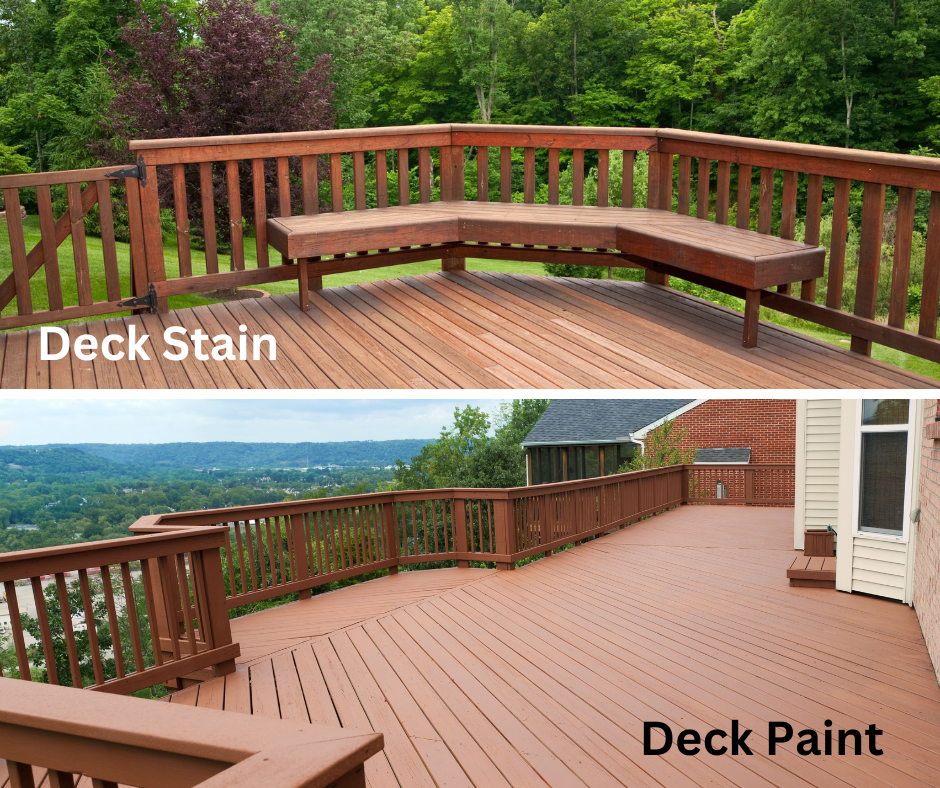Pressure-treated lumber has many advantages because it has chemicals to protect it from rot and decay, making it highly durable. This is particularly valuable for wood surfaces that are frequently exposed to the weather, such as deck boards and exterior trim. The only drawback is that the wood has a greenish tint that makes it look brand new and stands out noticeably.
Can pressure-treated lumber be painted? Yes, it can and it is recommended to enhance its protection, durability, and appearance. However, it’s important to keep in mind that pressure-treated wood is not indestructible and there are important factors to consider before painting to prevent costly mistakes.
What About The Curing Process / When Can You Paint Pressure-Treated Lumber?
To ensure good results, it is important to allow the wood to fully dry before painting. This process, sometimes known as seasoning or curing, usually takes about 4-6 months. Painting too soon can cause the boards to warp and result in poor paint adhesion. Therefore, it is recommended to be patient and allow the wood adequate time to dry before applying paint.
How To Test If Pressure-Treated Wood Is Cured?
To check if pressure-treated wood is ready for painting, wait for it to dry and cure completely. Then, sprinkle some water onto its surface and observe if it beads up or gets absorbed into the wood. If it beads up, the wood is cured and ready for painting. Otherwise, more time is needed for it to dry and cure.
What Are The Steps To Paint Treated Wood?
1. Prepare the Surface: Before painting pressure-treated wood, it is important to clean the surface with a brush or wire brush to remove any dirt, debris, and loose paint. Additionally, use sandpaper to smooth out any rough spots and eliminate splinters. Furthermore, it is recommended to use a wood cleaner such as bleach or an oxygenated cleaner to remove any remaining dirt, mold, or mildew.
2. Use a High-Quality Primer: To get the best results, it is essential to use a high-quality exterior primer before painting pressure-treated wood. This will ensure better paint adhesion and prevent peeling and cracking down the line. A latex-based primer is generally recommended as it works well with both oil-based paint and water-based paints.
3. Apply Quality Paint: Finally, when selecting paint, look for one that is suitable for outdoor use. A breathable paint or stain that can resist moisture and UV rays is best as it will help protect the wood from wear and tear caused by weather exposure. Additionally, make sure to check the instructions carefully as some paints might require two or more coats.
By following these steps, you can ensure a successful painting job for pressure-treated wood and keep its surface looking great for many years to come. With a little bit of effort, you’ll have an attractive and durable exterior that will last. So don’t be afraid to tackle this project—you can paint pressure-treated wood and enjoy the results for years to come.
Pro Contractor Tips
To paint pressure-treated wood, it is important to use multiple coats of paint. This will help ensure that the finish is even and long-lasting. Allow each coat to dry completely before applying a new coat on top.
Painting pressure-treated wood, it’s important to follow some tips for a successful result. Ensure that the workspace is properly ventilated and wear protective gear, like gloves and a face mask. Begin by painting the edges before moving on the rest of the wood with each layer to achieve a seamless finish.
Conclusion
In conclusion, painting pressure-treated wood is a relatively simple project that can have rewarding results. Using the right materials and techniques will ensure that your paint job stands up to the test of time. By understanding the material you are working with, properly prepping the surface, using multiple coats of paint, and adding a sealer for added protection, you can create a durable and attractive finish that you will be proud of. With careful preparation and attention to detail, painting pressure-treated wood is an excellent DIY project for any homeowner or enthusiast.
Frequently Asked Questions
Can You Stain Pressure Treated Lumber?
Yes, you can stain pressure-treated wood. However, there are a few considerations and steps to follow to ensure a successful staining process.
Allow the wood to weather: Freshly pressure-treated wood contains chemicals that help protect it against rot and insect damage. These chemicals also make it difficult for stains to penetrate the wood. It is recommended to let the wood weather for a few months before staining to allow the chemicals to leach out and the wood to completely dry.
Clean the wood: Before staining, clean the surface of the wood to remove any dirt, debris, or mildew that may have accumulated during the weathering process. You can use a wood cleaner or a mixture of water and mild detergent. Scrub the wood with a brush and rinse it thoroughly. Allow the wood to dry completely before proceeding.
To ensure you get the desired color and finish, it’s important to first test the stain on a small, inconspicuous area of the pressure-treated wood before applying it to the whole surface.
Choose the right stain: Select a high-quality exterior-grade stain that is specifically designed for use on pressure-treated wood. These stains are formulated to penetrate the wood effectively and provide long-lasting protection against the elements. Additionally, consider whether you want a transparent, semi-transparent, or solid-color stain, as this will affect the final appearance of the wood.
Apply the stain: Follow the instructions provided by the stain manufacturer for application techniques and drying times. Typically, you can apply the stain using a brush, roller, or sprayer. Ensure even coverage and work with the wood grain. Apply multiple coats if necessary, allowing each coat to dry fully before applying the next.
Remember, the color and appearance of the stain on pressure-treated wood may vary from what you would typically see on untreated wood. The stain may appear lighter or take longer to absorb into the wood due to the chemical treatment. It’s a good idea to consult the stain manufacturer’s recommendations for application on pressure-treated wood to achieve the best results.
What Happens If You Paint Uncured Pressure Treated Wood?
Painting uncured pressure-treated wood can lead to several issues. Pressure-treated wood is typically treated with chemicals, such as chromated copper arsenate (CCA) or alkaline copper quat (ACQ), to enhance its resistance to rot, decay, and insect infestation. These chemicals are usually impregnated into the wood through a pressure treatment process.
When pressure-treated wood is uncured, it means that the treatment process is not complete, and the wood has not had enough time to dry or off-gas the chemicals properly. Painting uncured pressure-treated wood can result in the following problems:
Poor Adhesion: Uncured pressure-treated wood often contains excess moisture, which prevents proper adhesion of paint. The moisture can cause the paint to bubble, peel, or flake off, leading to an uneven and unsightly finish.
Discoloration: The moisture trapped within the wood can cause tannins and other natural compounds to leach out, resulting in discoloration or staining of the paint. This can lead to an uneven appearance or spots of darkened or discolored paint.
Reduced Durability: Painting uncured pressure-treated wood can hinder the wood’s ability to dry out naturally. This trapped moisture can contribute to ongoing decay, rot, or mold growth within the wood, reducing its overall durability and lifespan.
Health and Safety Concerns: The chemicals used in pressure treatment, such as CCA or ACQ, can be harmful if not fully cured or sealed. Painting uncured pressure-treated wood may trap these chemicals beneath the paint, potentially posing health risks if they come into contact with skin or are released into the surrounding environment.
To avoid these issues, it is generally recommended to allow pressure-treated wood to cure and dry thoroughly before painting. The curing time can vary depending on factors such as the wood’s thickness, climate, and exposure to sunlight. It is advisable to consult the manufacturer’s instructions or seek professional advice to determine the appropriate curing time before applying paint or other finishes to pressure-treated wood.
How Long Will Pressure Treated Wood Last If It’s Painted?
Pressure-treated wood, when properly painted and maintained, can have an extended lifespan compared to untreated wood. The paint serves as a protective barrier against moisture, UV radiation, and other environmental elements that can contribute to the deterioration of wood. However, the exact duration of how long pressure-treated wood will last when painted can vary depending on several factors:
Quality of paint: Using high-quality exterior paint specifically designed for wood can enhance the durability and longevity of the finish. Quality paints are formulated to withstand outdoor conditions and provide better protection against weathering.
Preparation and application: Proper surface preparation, including cleaning and sanding, is crucial for ensuring good paint adhesion. Applying multiple coats of paint according to the manufacturer’s instructions and allowing sufficient drying time between coats can improve the protective properties of the paint.
Environmental conditions: The climate and weather in your specific location can significantly impact the lifespan of painted pressure-treated wood. Regions with more extreme weather conditions, such as high humidity, intense sunlight, or frequent temperature fluctuations, may lead to faster degradation of the paint and the underlying wood.
Maintenance: Regular maintenance, such as cleaning the painted surface, inspecting for any signs of damage, and recoating with paint as needed, can help extend the lifespan of the painted pressure-treated wood. Repainting every few years or as recommended by the paint manufacturer can help maintain its protective properties.
On average, a well-maintained and properly painted pressure-treated wood surface can last for 10 to 20 years or more. However, it’s important to note that this estimate can vary based on the factors mentioned above. Regular inspections and maintenance are key to ensuring the longevity of the painted pressure-treated wood.
Can I Paint Kiln Dried Pressure Treated Wood Sooner?
Kiln-dried pressure-treated wood is typically ready for painting sooner than non-kiln-dried wood. Kiln drying accelerates the moisture removal process, reducing the moisture content of the wood more quickly compared to air-drying or other methods. As a result, kiln-dried wood generally reaches a lower moisture content faster, allowing it to be painted sooner.
Will painting treated wood with exterior latex paint help resist rot?
Yes, painting treated wood with exterior latex paint can help resist rot and protect the wood’s natural vulnerability. Exterior latex paint creates a protective barrier on the surface of the wood, which helps to prevent moisture from penetrating the wood and causing rot. It also provides a layer of protection against the damaging effects of sunlight, such as UV rays, which can cause the wood to degrade over time.


